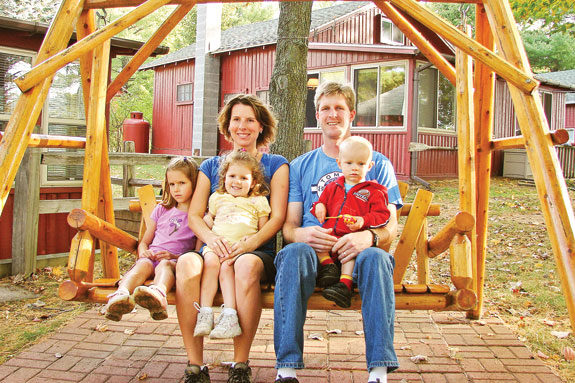Scott Seaver of Montague, Michigan, developed a useful connection between this technology and hay baling.
“Essentially the [trailers] have air bags between the axles and the frame,” Seaver says. “It gives them a better ride because the air is compressible and it adjusts to different road conditions very quickly.”
Seaver explains how he used these same special air bags and an air tank to improve bale consistency in small-square bales.
“The air bags are flexible,” Seaver explains, “but they can still apply a force in opposing directions.”
As field conditions change, the pressure on the air bags in Seaver’s baler is altered so that bales will weigh within a few pounds of each other.
Both the air bag and air tank are set at the same pressure. When the air bag changes positions, the excess air will flow into the tank, or if there is less air, the tank can pump extra air into the bag.
Seaver found the need to invent what he calls the AirBaler once he bought a New Holland hay wagon.
“We always baled hay and stacked it by hand on a wagon, so we were touching every bale,” Seaver explains. “If the weight of a bale got off a bit, we’d just hop off the wagon and make a little adjustment and keep going.

Ten years ago I bought a New Holland hay stacker, so we were dropping all the bales on the ground and nobody was touching them any more.”
The consistency of bale weight was something Seaver had to have while using his New Holland hay wagon.
Before inventing his system, Seaver talked with several of his friends who also grew hay. Matt Waller, one of Seaver’s neighbors, had recently bought a hydraulic tension system.
The system constantly pumped hydraulic fluid. A dial on the side of the system controlled how much pressure was being put on the bale chamber.
“When we got the hydraulic tension system,” Waller says, “we were under the impression that once you set the pressure it would adjust one way or another, if you had heavy or light windrows. You could control the hydraulic tension with a knob that you could turn, but if the windrows were too heavy or too light, it would not correct itself.”
Seaver decided that the hydraulic tension system was not going to help solve his problems. That’s when he decided to invent his new product to work as he would hope. While driving his tractor in the hay field, Seaver’s mechanical engineering experience led him to think of using the air bag concept.
“I tested it on my farm from 2003 to 2007,” Seaver says. “We used the AirBaler on about 50,000 bales in that time frame.”
Observing his neighbor’s ongoing tests, Waller’s curiosity finally led him to ask Seaver what he was experimenting with on the back of his baler. At this point Seaver was ready to test what other farmers thought about his invention.
“Scott decided he was going to market this thing, so he wanted other guys to test it out,” Waller recalls. “He would troubleshoot his ideas and have us suggest any problems that we thought might happen.”
Waller commends Seaver for all of the work that he put into this product. Many cases of trial and error occurred. Waller laughs at the memory of Seaver’s truck backed up to his shop while he worked to fix “kinks” in the system.
According to Seaver’s website, the system takes about two and a half hours to install. It is also compatible with all top manufacturers of small-square balers, including John Deere, Case/International, New Holland, Hesston and Massey-Ferguson.
Seaver maintains this system is the only one that can self-adjust to changes to windrow conditions on the go, so that bales will weigh only a few pounds difference, making farmers more productive.
Click here for more information on the AirBaler system and how to order it. FG










